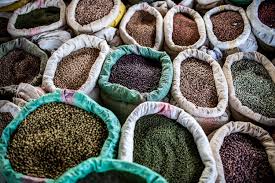The impact of plant breeding programmes on food production depends on the quality, efficiency of seed distribution, and its availability to farmers.
Good quality seeds ensure genetic purity of variety, high germination capability, freedom from seed-borne diseases, freedom from impurities, and seeds of noxious weeds.
Recognised Classes of Agricultural Seeds
There are four classes of seed recognized by Seed Certification Agencies:
1. Breeder Seed: This is a small quantity of pure seed directly produced by the plant breeder or originating institution.
2. Foundation Seed: This is the progeny (baby) of breeder seed. The genetic identity and purity of the variety is maintained in foundation seed. Foundation seed is the source of all certified seed classes, either directly or through registered seed.
3. Registered Seed: This is the direct increase from foundation seed. Registered seed is used as the source of certified seed in some crops.
4. Certified Seed: This is the progeny of foundation seed or registered seed. Its production is guaranteed by inspection and certification by an independent agency. In Nigeria, the National Agricultural Seeds Council (NASC) serves in this capacity.
Read Also: Feed Lot Fattening of Rams Practice
Maintenance of Varietal Purity in Crop Seeds

In self-pollinated crops like cowpea and soybean, the maintenance of varietal purity is not a serious problem provided the right class of seed is used and mechanical mixtures are avoided. Adequate rouging, avoidance of volunteers, and the use of approved seed sources for planting reduce the danger of varietal contamination.
The maintenance of varietal purity in cross-pollinating varieties follows similar practices, except that the field must be isolated from other fields with a distance of about 400 meters.
Essential Elements of Agricultural Seed Production
Production of high-quality seeds requires a number of steps as described below:
1. Use of genetically pure seeds of the given variety from a dependable source.
2. Seed should be multiplied on clean land to prevent volunteer plants.
3. The variety should have proper isolation of specified distance from other varieties of the same species. In self-pollinating crops, 3 to 4 meters between the different varieties is adequate.
4. Proper cultural practices, fertilizer application, insecticides, and weed control have a great influence on seed quality and quantity as well as the economics of seed production.
5. Field inspection is important. It involves identification of the variety, determination of varietal purity, and recognition of diseases and off-types. Rouging of diseased plants and varietal mixtures should be done at appropriate growth stages.
Rouging should be done at least three times: at pre-flowering stage, flowering stage, and at maturity using flower colour, leaf shape, pubescent (hair), etc.
6. Harvesting must be done at the right maturity and moisture content to ensure good quality seed.
7. Drying and threshing should be done timely and carefully to prevent damages and mechanical mixtures. Seeds are often treated with chemicals as protection against seed-borne and soil-borne diseases.
8. There should be timely, proper testing of seeds in the laboratory. Laboratory seed tests include verification of identity and varietal purity, moisture content, germination percentage, and health status.
Read Also: General Principles of Goat Production
Seed Distribution for Agricultural Use

A variety is ready for release and distribution when it has been proved to be distinctly superior to existing commercial varieties in at least one or more traits and satisfactory in all other important attributes.
First distribution of foundation seed is usually made to selected farmers who by past experience have proved their ability to produce registered and certified seed with a high standard of quality.
Distribution of certified seed is made to certified growers throughout the country. The certified seed harvested from this increase then becomes available without restriction to any grower as the seed supplies are available.
The primary aim of crop breeding is to supply good quality seeds of high yielding to farmers, and there are four classes of seeds recognized by the seed certification agencies.
Do you have any questions, suggestions, or contributions? If so, please feel free to use the comment box below to share your thoughts. We also encourage you to kindly share this information with others who might benefit from it. Since we can’t reach everyone at once, we truly appreciate your help in spreading the word. Thank you so much for your support and for sharing!

